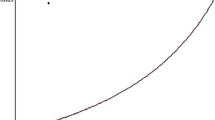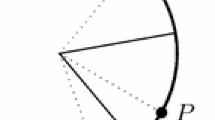Abstract
We present a model of multi-party, “spatial” competition under proportional rule with both electoral and coalitional risk. Each party consists of a set of delegates with heterogeneous policy preferences. These delegates choose one delegate as leader or agent. This agent announces the policy declaration (or manifesto) to the electorate prior to the election. The choice of the agent by each party elite is assumed to be a local Nash equilibrium to a game form \(\tilde g\). This game form encapsulates beliefs of the party elite about the nature of both electoral risk and the post-election coalition bargaining game. It is demonstrated, under the assumption that \(\tilde g\) is smooth, that, for almost all parameter values, a locally isolated, local Nash equilibrium exists.
In the final section of the paper some empirical work is reviewed in order to obtain some insights into why parties do not simply converge to an electoral center in order to maximize expected vote shares.
Similar content being viewed by others
References
J. Adams and S. Merrill, Modeling party strategies and policy representation in multiparty elections: Why are strategies so extreme?, American Journal of Political Science 43 (1999) 765-791.
A. Arian and M. Shamir, eds., The Election of 1992 in Israel (SUNY Press, Albany, 1995).
A. Arian and M. Shamir, eds., The Election of 1996 in Israel (SUNY Press, Albany, 1999).
J. Banks and J. Duggan, A bargaining model of collective choice, American Political Science Review 94 (2000) 73-88.
J. Banks and J. Duggan, The theory of probabilistic voting in the spatial model of elections, Unpublished typescript, California Institute of Technology (1998).
J. Banks, J. Duggan and M. Le Breton, Bounds for mixed strategy equilibria and the spatial model of elections, Journal of Economic Theory 103 (2002) 88-105.
J. Banks, J. Duggan and M. Le Breton, Notes on the uncovered set, Unpublished typescript, California Institute of Technology (1998).
D. Baron, A spatial bargaining model of government formation in parliamentary systems, American Political Science Review 85 (1991) 137-164.
R. Calvert, Robustness of the multidimensional voting model: Candidates, motivations, uncertainty and convergence, American Journal of Political Science 29 (1985) 69-85.
G. Cox, An expected-utility model of electoral competition, Quality and Quantity 18 (1984) 337-349.
G. Cox, The uncovered set and the core, American Journal of Political Science 31 (1987) 408-422.
G. Cox, Centripetal and centrifugal incentives in electoral systems, American Journal of Political Science 34 (1990) 903-945.
H. Daalder, In search of the center of European party systems, American Political Science Review 78 (1984) 92-109.
E. Dierker, Topological Methods in Walrasian Economics (Springer, Heidelberg, 1974).
M. Duverger, Political Parties: Their Organization and Activity in the Modern State (Wiley, New York, 1954).
C. Eaton and R. Lipsey, The principle of minimal differentiation reconsidered: Some new developments in the theory of spatial competition, Review of Economic Studies 42 (1975) 27-50.
M. Golubitsky and V. Guillemin, Stable Mappings and their Singularities (Springer, Heidelberg, 1976).
B. Grofman and S. Merrill, A Unified Theory of Voting (Cambridge University Press, Cambridge).
M. Hirsch, Differential Topology (Springer, Heidelberg, 1976).
M. Laver and N. Schofield, Multiparty Government: The Politics of Coalition in Europe (Oxford University Press, Oxford, 1990). Reprinted (Michigan University Press, Ann Arbor, 1998).
T. Lin, J. Enelow and H. Dorussen, Equilibrium in multicandidate probabilistic spatial voting, Public Choice 98 (1999) 59-82.
O. Listhaug, S.E. Macdonald and G. Rabinowitz, A comparative analysis of European party systems, Scandinavian Political Studies 13 (1990) 227-254.
R.D. McKelvey, Covering, dominance and institution-free properties of social choice, American Journal of Political Science 30 (1986) 283-314.
R.D. McKelvey and N. Schofield, Generalized symmetry conditions at a core point, Econometrica 55 (1987) 923-933.
E. Michael, Continuous selections I, Annals of Mathematics 63 (1956) 361-382.
N.Miller, A new solution set for tournaments and majority voting: Further graph-theoretic approaches to the theory of voting, American Journal of Political Science 24 (1980) 68-96.
J. Milnor, Morse Theory (Princeton University Press, Princeton).
K.R. Parthasathy, Probability Measures on Metric Spaces (Academic Press, New York, 1967).
K. Quinn, A. Martin and A. Whitford, Voter choice in multiparty democracies: A test of competing theories and models, American Journal of Political Science 43 (1999) 1231-1247.
D. Saari, Generic existence of a core for q-rules, Economic Theory 9 (1997) 219-260.
N. Schofield, Existence of a smooth social choice functor, in: Social Choice, Welfare and Ethics, eds. W. Barnett, H. Moulin, N. Schofield and M. Salles (Cambridge University Press, Cambridge, 1995).
N. Schofield, Aggregation of smooth preferences, Social Choice and Welfare 15 (1998) 161-185.
N. Schofield, The C 1-topology on the space of smooth preference profiles, Social Choice and Welfare 16 (1999) 347-373.
N. Schofield, A smooth social choice method of preference aggregation, in: Topics in Mathematical Economics and Game Theory, ed. M. Wooders (Fields Institute for the American Mathematical Society, Providence, RI, 1999).
N. Schofield, The heart and the uncovered set, Journal of Economics: Zeitschrift fur Nationaloekonomie, Supplement 8 (1999) 79-113.
N. Schofield, D. Giannetti, A.Martin, K. Quinn and I. Sened, Representative democracy and electoral rules, Working Paper No. 208, Center in Political Economy, Washington University (2000).
N. Schofield, A. Martin, K. Quinn and A. Whitford, Multiparty electoral competition in the Netherlands and Germany: A model based on multinomial probit, Public Choice 97 (1998) 257-293.
N. Schofield and R. Parks, Nash equilibrium in a spatial model of coalition bargaining, Mathematical Social Sciences 39 (2000) 133-174.
N. Schofield, I. Sened and D. Nixon, Nash equilibrium in multiparty competition with “stochastic” voters, Annals of Operations Research 84 (1998) 3-27.
Author information
Authors and Affiliations
Rights and permissions
About this article
Cite this article
Schofield, N., Sened, I. Local Nash Equilibrium in Multiparty Politics. Annals of Operations Research 109, 193–211 (2002). https://doi.org/10.1023/A:1016304319551
Issue Date:
DOI: https://doi.org/10.1023/A:1016304319551




